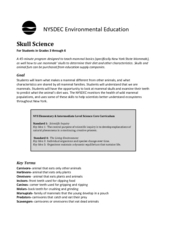Virginia Department of Education
Molar Heat of Fusion for Water
How can you describe heat of fusion in a way the class understands and relates the importance of this concept to present day issues? In this third activity of the series, learners conduct an experiment, demonstrating the flow of heat...
American Museum of Natural History
Super Teeth
A brief comparison of human teeth versus animal teeth sets the stage for two worksheets. Scholars match a picture of a tooth-filled mouth to the animal to which it belongs and coloring pages featuring a different animal and informative...
Howard Hughes Medical Institute
Explore Your Inner Animals
Human bodies prove evolution thanks to our genes, bones, and more. Learning about specific body parts and how they evolved from other species helps individuals better understand the transition species that helped us become who we are today.
Curated OER
All About Teeth
Chomp chomp! Learn which teeth perform which tasks with a thorough worksheet on molars, incisors, and canines. Based on descriptions of each kind of tooth, fifth graders label a diagram that points to particular teeth. They then color in...
Cheetah Outreach
Nutrition
What can teeth tell us about an animal's diet? Learners examine animal skulls to determine what their canines, incisros, premolars, and molars reveal.
Curated OER
Bite on This!
Different types of teeth have different roles. Third graders study how molars, incisors, and canines function in a rabbit skull and a cat skull. After answering some questions about the teeth of herbivores and carnivores, kids...
Curated OER
Water:Properties, Chapter 3
Hydrogen bonds, and polarity are described in this PowerPoint, and the reasons for tension and cohesion associated with water. The states of water under certain conditions are explained with information about the changes in density and...
Curated OER
What Animals Eat
First graders organize animals according to what they eat. They compare the teeth of plant eaters and meat eaters.
Curated OER
Teeth and Eating
Students conduct online research of different animals and their diet. In this animal instructional activity, students identify the various types of diets each animals has and their teeth. This research is done on the Internet.
Curated OER
Tell Me About Teeth
In this science worksheet, learners investigate the purpose of teeth, types of teeth, their anatomy, dental care, animal skulls and teeth, parts of a tooth and related topics by reading and completing the activities on the 8 full color...
Curated OER
Mammals: Teeth and Diet
In this mammals' teeth and diet worksheet, students read for information, identify kinds of teeth, and sort animals into categories. In this fill in the blank and T-Chart worksheet, students write multiple answers for two questions.
American Museum of Natural History
Extreme Mammals
Extreme characteristics can create some unusual mammals. Learners flip through a slide show of some of the most interesting mammals that are both living and extinct. Implement as a remote learning resource or use in-class to review...
Curated OER
Adaptations of the Beak
Students examine the principles of adaptation using mouth structure of animals as an example. Students look specifically at the various shapes of beaks of birds and the bill of the platypus.
Curated OER
Adaptations
Students identify what adaptation is and to research a specific mollusk. They also identify and interpret how animals get their common and scientific name and why it is Latin. Finally, students draw their shell (mollusk) and name their...
Curated OER
Wildlife Animal Skulls
Students observe skulls of wild animals and determine their characteristics for survival. They evaluate the skuylls to discover the diets, and if the animals were predators or prey. They complete worksheets on mystery skulls.
Curated OER
Teeth And Eating
Students explore and study all about teeth and eating. They examine types of teeth, how their teeth develop, looking after teeth and teeth in other animals. Each student also reviews the process of how teeth help all mankind to eat food.
Curated OER
Mammal Characteristics
In this mammal characteristics, students study diagrams to compare the different types of teeth found in herbivores and carnivores. This worksheet has 1 short answer and 2 multiple choice questions.
Curated OER
Using Your Teeth
In this Using Your Teeth worksheet, students read information about teeth and then complete the labels for a diagram about teeth. Students also think about the differences between human and animal teeth and design an information leaflet...
Desert Discoveries
What's For Dinner?
Youngsters compare the teeth of plant-eating dinosaurs with those of meat-eating dinosaurs. The concepts of herbivore vs. carnivore are also introduced. There is an excellent worksheet embedded in the plan which shows five skulls of...
Curated OER
Skull Science
What can your class learn from a skull? With proper facilitation, they can learn about diet, physical adaptations, special differences, and even the environment. Pupils will examine a series of mammal skulls and pelts to help them...
Curated OER
Who Lives with Mallard?
Young scholars color a picture of the habitat featuring mallard and other creatures, some of whom might be camouflaged or half-hidden. They discuss other forms of animal adaptation.
Curated OER
What Happens to the Food You Eat? The Digestive System
Young scholars observe a video displaying body parts and functions of the digestive system. They make drawings of the digestive system from their observations. They act out a short play involving body parts.
Curated OER
IB Chemistry Practice Test
In this chemistry review worksheet, students practice using Avogadro's number, calculating number of moles, and using the gas laws. This worksheet has 39 multiple choice questions.
Curated OER
Fun with Fossils
Second graders explore the geologic process of fossil formation. In this geology lesson, 2nd graders discuss the job of a paleontologist and make their own model of a fossil. This lesson includes teacher directed questions.

























